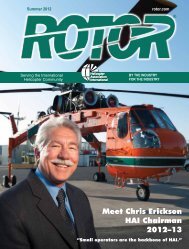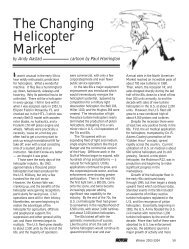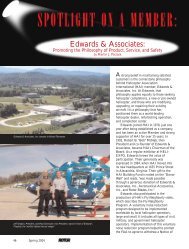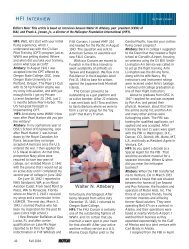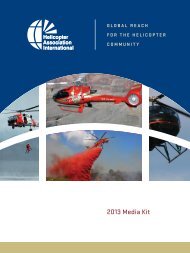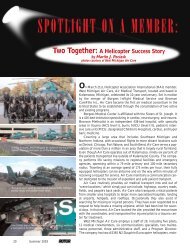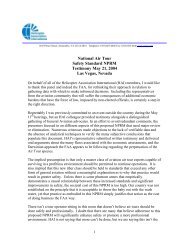The San Diego Regional Fire and Rescue Helicopter Program Starts ...
The San Diego Regional Fire and Rescue Helicopter Program Starts ...
The San Diego Regional Fire and Rescue Helicopter Program Starts ...
Create successful ePaper yourself
Turn your PDF publications into a flip-book with our unique Google optimized e-Paper software.
Let’s get started!<br />
Day 4<br />
<strong>The</strong> <strong>San</strong> <strong>Diego</strong><br />
<strong>Regional</strong> <strong>Fire</strong> <strong>and</strong><br />
<strong>Rescue</strong> <strong>Helicopter</strong><br />
<strong>Program</strong> <strong>Starts</strong> Off<br />
With <strong>Helicopter</strong><br />
Hoist Training<br />
by Michael R. Mitchell<br />
Photos courtesy of Michael R. Mitchell<br />
Stretcher tag line lift<br />
Single man lift<br />
On June 23rd 2003, the <strong>San</strong> <strong>Diego</strong> <strong>Fire</strong> <strong>and</strong> <strong>Rescue</strong><br />
<strong>Helicopter</strong> <strong>Program</strong> started operational hoist training, <strong>and</strong><br />
on July 1 they went live. While they had the helicopter last<br />
year, 2003 marks the first year that the program had a rescue<br />
hoist capability. Captain Brian Fennessy, who worked<br />
for over six years to get the program to this point, was one<br />
of only two <strong>San</strong> <strong>Diego</strong> wildl<strong>and</strong> firefighters qualified to<br />
operate the hoist. <strong>The</strong> start of the training was the culmination<br />
of over two years of communication <strong>and</strong> coordination<br />
between Brian <strong>and</strong> myself, Michael R. Mitchell,<br />
President of Zephyr International, in order to select the<br />
appropriate hoist <strong>and</strong> arrange the best suitable training<br />
program. This program is completely funded by private<br />
donations <strong>and</strong> supported by local industries.<br />
<strong>The</strong> Kachina Bell 212 helicopter was outfitted with a<br />
Goodrich model 42305-3 rescue-hoist, provided by<br />
Goodrich under a special arrangement, specifically for this<br />
program. <strong>The</strong> hoist is internally mounted <strong>and</strong> can lift up to<br />
six hundred pounds of human payload <strong>and</strong> rotate them into<br />
the cabin. <strong>The</strong> rotation capability is a feature that is highly<br />
valued by a rescue crew conducting an external human load<br />
mission.<br />
Prior to the actual operational hoist training, the<br />
Kachina facility maintenance crew, who had successfully<br />
completed the maintenance training provided by Zephyr<br />
International, installed the hoist in Boise, Idaho. <strong>The</strong> inclusion<br />
of the maintenance training demonstrates the importance<br />
the <strong>San</strong> <strong>Diego</strong> <strong>Regional</strong> <strong>Fire</strong> <strong>and</strong> <strong>Rescue</strong> Authority<br />
places on the proper operation <strong>and</strong> maintenance of this<br />
critical piece of equipment. <strong>The</strong> Zephyr maintenance<br />
training lasted three days. On day one, the technicians were<br />
trained on the inner workings of the 42305-3 hoist rescue<br />
system. Day two was spent installing the hoist <strong>and</strong> going<br />
through all the maintenance requirements which are essential<br />
at set up, for achieving optimal performance <strong>and</strong> safely<br />
<strong>and</strong> economically maintaining the equipment. Each person<br />
involved in the training program received h<strong>and</strong>s-on<br />
24 Fall 2003
training on all the maintenance procedures. <strong>The</strong> third day<br />
was dedicated entirely to the construction <strong>and</strong> behavior of<br />
the hoist wire rope; which is the most important <strong>and</strong> critical<br />
component of the hoist system <strong>and</strong> about which there is<br />
much to learn. <strong>The</strong> details of its inspection <strong>and</strong> rejection<br />
criteria were thoroughly briefed to the technicians who are<br />
responsible for maintaining the rescue hoist along with the<br />
rest of the aircraft. At the end of the maintenance training,<br />
the technicians had a new awareness of the unique role <strong>and</strong><br />
critical function that the rescue hoist <strong>and</strong> wire rope cable<br />
play in the total aircraft rescue system.<br />
Following the maintenance training in Idaho, the Bell<br />
212 was flown to <strong>San</strong> <strong>Diego</strong> for the hoist operations training<br />
which lasted seven days <strong>and</strong> was conducted by<br />
<strong>Helicopter</strong> <strong>Rescue</strong> Consult (HRC), Managing Director,<br />
Werner Greipl. Greipl is a mountain rescue expert, aeronautical<br />
engineer, helicopter pilot, <strong>and</strong> an experienced<br />
hoist training expert <strong>and</strong> practitioner. Hoist operations<br />
training began with two days of classroom education, in<br />
which HRC provided a complete operating philosophy <strong>and</strong><br />
manual that was tailored to the customer's helicopter <strong>and</strong><br />
hoist rescue system.<br />
Day one covered basic hoist education, how the hoist<br />
works, <strong>and</strong> how it interfaces with the helicopter. <strong>The</strong>y also<br />
examined the HRC hoist operation philosophy, which is to<br />
minimize time in the "dead-mans curve," if possible, <strong>and</strong><br />
how to operate when it is not possible. Crew coordination<br />
<strong>and</strong> communication, static electricity discharge, <strong>and</strong> emergency<br />
operations were also discussed. <strong>The</strong> trainees for day<br />
one consisted of two crew chiefs <strong>and</strong> three pilots. Day two<br />
classroom training included weight <strong>and</strong> balance calculations,<br />
power availability <strong>and</strong> pressure altitude, the different<br />
types <strong>and</strong> placement of equipment depending on the mission,<br />
preflight planning, communications, <strong>and</strong> rescue<br />
equipment basics. In addition to day one trainees, the day<br />
two training included the firefighters <strong>and</strong> paramedics who<br />
would be the down wire rescuers.<br />
Flight training began on day three. Each pilot <strong>and</strong> crew<br />
chief was required to fly basic hoist operations with a<br />
dummy load. <strong>The</strong> assignment was to try to put the load on<br />
a specific location. This develops the necessary skills needed<br />
for the hoist operators to perform various tasks in combination:<br />
talking the pilot in, running the hoist, <strong>and</strong> getting<br />
a feel for the hoist response, all while trying to minimize<br />
the amount of time in a hover. Thirty-five hoist cycles were<br />
performed on day three. During that day, the crews began<br />
to get the feel of the system <strong>and</strong> during the post flight briefing<br />
when the crews were shown the video from the hoist<br />
boom head it became clear that controlling the helicopter<br />
hoist system was not as easy as it looks on TV.<br />
Day four was spent flying <strong>and</strong> practicing emergency<br />
procedures: wildly swinging loads, lost communications,<br />
<strong>and</strong> one engine inoperative hoist recovery. This was the<br />
most stressful day for the trainers <strong>and</strong> trainees. Each mission<br />
profile was thoroughly briefed beforeh<strong>and</strong> <strong>and</strong> all participants<br />
had a say in the way the mission would be executed.<br />
At the end of the day, the hoist operators demonstrated<br />
the ability to control a swinging load, <strong>and</strong> continue<br />
Going over the hoist details on ground<br />
Getting the media’s attention<br />
Brian Fennessey addressing supporters of the program<br />
<strong>San</strong> <strong>Diego</strong> <strong>Rescue</strong> 1 Trainees, from top down to the right: Julie,<br />
Harold, Brian, Wayne, Werner, Joe, Greg, Lyle, Unknown Victim,<br />
Spanky, Dennis, Bob, Bill, Derek, Mike not shown<br />
Fall 2003<br />
25
the hoist mission after a communication<br />
drop out. <strong>The</strong> pilots <strong>and</strong> the<br />
hoist operators experienced the feeling<br />
of rapid altitude loss <strong>and</strong> flying<br />
away while the load was retracted<br />
<strong>and</strong> controlled as fast as possible.<br />
Twenty-one hoist cycles were performed<br />
on this day.<br />
Day five was the start of the live<br />
lifts <strong>and</strong> all the firefighters <strong>and</strong> paramedics<br />
went through ground training<br />
on the procedures <strong>and</strong> equipment<br />
that would be used that day. <strong>The</strong><br />
day's activities were to be single-person<br />
lifts, <strong>and</strong> later double-person<br />
lifts. We were able to complete<br />
twelve single-person lifts before one<br />
of the generators on the aircraft<br />
failed, forcing us to reconvene to the<br />
classroom; where the litter bag<br />
equipment, the operations using a<br />
tag-line, <strong>and</strong> the fly away method of<br />
litter hoisting were briefed. Later<br />
that afternoon the generator was<br />
repaired, enabling us to start flying<br />
again the next day.<br />
Day six began where we left off<br />
the day before. Fourteen more single-person<br />
lifts, thirteen double-person<br />
lifts, <strong>and</strong> twelve stretcher operations<br />
were performed. At the end of<br />
the day all the trainees were demonstrating<br />
first-rate skills at their jobs.<br />
Day seven activities included<br />
three simulated rescue missions. In<br />
each case a victim was flown into the<br />
surrounding hills <strong>and</strong> instructed on<br />
the nature of injury they were to simulate.<br />
<strong>The</strong> victim then was hoisted<br />
down in order to perform the simulation<br />
<strong>and</strong> the location was totally up to<br />
the victim to choose. In the mean-<br />
You want me to ride this thing?<br />
time, the helicopter returned to base<br />
where the rescue crew waited for the<br />
simulated emergency call. <strong>The</strong> crew<br />
was tasked with executing the entire<br />
mission with minimal intervention<br />
by the trainers.<br />
We then had the opportunity to<br />
fly two more rescue scenarios. I was<br />
to be the simulated victim on the<br />
next mission <strong>and</strong> my simulated<br />
injury was to be a spinal injury.<br />
Once hoisted down, I decided on a<br />
sunny spot on a hill between two<br />
trees <strong>and</strong> next to a large bush. A<br />
paramedic was hoisted down to<br />
ascertain my condition. Once he stabilized<br />
me, he requested the backboard<br />
<strong>and</strong> the litter. As the helicopter<br />
approached again, another paramedic<br />
was hoisted down with the<br />
backboard <strong>and</strong> the litterbag. I was<br />
strapped to the backboard <strong>and</strong> the<br />
paramedics discussed their options<br />
for hoisting me out. <strong>The</strong> helicopter<br />
returned <strong>and</strong> hoisted up the first<br />
paramedic, then orbited <strong>and</strong><br />
returned to double hoist the paramedic<br />
<strong>and</strong> myself still inside the litterbag.<br />
Due to the position I was in<br />
<strong>and</strong> being at the bottom of a gully<br />
between two trees, a tag line hoist<br />
was not feasible. Soon after the helicopter<br />
got us off the ground, I realized<br />
we were hung up in the big bush<br />
just uphill from where I had fallen.<br />
<strong>The</strong> helicopter quickly backed us<br />
out <strong>and</strong> all I could see was the cable<br />
out in front of my face <strong>and</strong> the helicopter<br />
above me. What I didn't know<br />
or feel was that we were already in<br />
forward flight <strong>and</strong> the litter was flying<br />
without rotation as a result of the<br />
clean air we were in. I watched that<br />
cable carefully, every couple of seconds<br />
it would rotate very quickly <strong>and</strong><br />
then stop as the twist was forced<br />
down the cable by the hoist action.<br />
Without a properly maintained hook<br />
bearing, that litter would have been<br />
spinning as a result of the cable twisting.<br />
I breathed a sigh of relief as the<br />
hoist began rotating into the cabin;<br />
the total hoisting time probably took<br />
less then two minutes. Once they<br />
secured me into the cabin, I realized<br />
we were already l<strong>and</strong>ing. <strong>The</strong> paramedics<br />
quickly lifted me out of the<br />
ship <strong>and</strong> while I looked up at the<br />
rotor blades off to my right, they<br />
opened the bag <strong>and</strong> I realized they<br />
had flown back to the base, a distance<br />
of at least three miles while<br />
they were completing the lift. Not<br />
only did they prevent the load from<br />
spinning, but they also minimized the<br />
total transport time. During the mission<br />
debriefing the point was made<br />
to try to move the victim away from<br />
obstacles whenever possible, such as<br />
the bush we encountered.<br />
Finally the last mission was flown;<br />
it was a rock face pick-off using the<br />
triangle. <strong>The</strong> triangle looks like a<br />
diaper but is fast <strong>and</strong> easy to attach<br />
to a victim. <strong>The</strong> mission was a success<br />
<strong>and</strong> we then returned to the airport<br />
for a written test, which every<br />
trainee is required to complete at the<br />
end of the course. Everyone passed.<br />
After each flight the hoist was<br />
given a thorough post flight inspection<br />
<strong>and</strong> the Kachina maintenance<br />
crew expertly maintained the helicopter.<br />
Each trainee received a certificate<br />
acknowledging that they had<br />
received the HRC Training <strong>Program</strong><br />
<strong>and</strong> demonstrated proficiency in<br />
their roles.<br />
For the <strong>San</strong> <strong>Diego</strong> <strong>Fire</strong> <strong>and</strong><br />
<strong>Rescue</strong> <strong>Helicopter</strong> <strong>Program</strong> Team it<br />
was just the beginning of further<br />
training in order to be the best they<br />
can be, so that they will be prepared<br />
when the next real call for a helicopter<br />
hoist emergency mission<br />
comes in.<br />
Michael R. Mitchell is President of<br />
Zephyr International LLC<br />
26 Fall 2003



